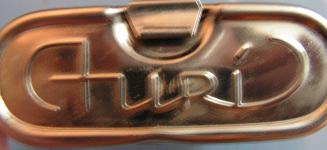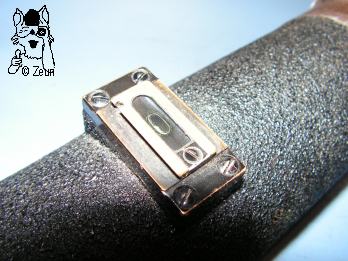Carl Zeiss "Aseros" 4x-20x48 (milit.)
| Dieses Carl Zeiss "Aseros" Teleskop mit Zoombereich von 4x bis 20x ist eine militärische Variante als Zielfernrohr (vgl. ziviles Modell). Das "Aseros" wurde für die Finnische Armee gefertigt oder von dieser umgebaut. Dementsprechend ist der Stempel der Finnsichen Armee "SA" (Suomi Armee) sowohl am Fernrohr als auch an der Batteriebox zu finden. Das Fernrohr ist in einer grün lackierten Holzkiste mit der Aufschrift "Tähtäinkaukoputki No. ...", was für "Fernrohr Nr. " steht. Eine Nummer ist jedoch nicht aufgemalt. Die 58,5x19x10cm große Kiste hat zwei Verschlüsse und einen Tragegriff. Neben dem Fernrohr befindet sich ein Beleuchtungseinheit darin. Diese besteht aus einer Batteriebox mit den Beschriftungen "turi" am Deckel und "G.W. Sohlberg H:ki" an der Deckellasche (evtl. der Hersteller der Einheit), sowie dem "SA" Stempel und einem Löwenkopfemblem an der Seite. An der Batterie lässt sich ein Kabel anschrauben, dessen anderes Ende die aufsteckbare Lampe enthält. Diese Lampenfassung lässt sich per Hebel auch zuklappen oder dimmen. Das Aseros ist dafür mit einem Beleuchtungsfenster für das vorhande Fadenkreuz ausgestattet. Die Lampenfassung wird mit einer Schwalbenschwanz-Schiene auf den Fenstersockel geschoben und rastet dort ein. | This Carl Zeiss "Aseros" telescope with a zoom range from 4x to 20x is a military gun-sight variant of the civilian model. The Aseros was made for or refurbished by the Finnish Army. So, there is the Finnish Army stamp "SA" (Suomi Army) at the telescope as well as at the battery box. The telescope come with a green painted wooden case inscribed "Tähtäinkaukoputki No. ...", which stands for "Telescope Nr. ...". Yet a number is mising. The 58.5x19x10cm case has two latches and a carrying handle. Besides the telescope there is a lighting unit in the case. The unit cinsists of a battery box marked "turi" at its lid, and "G.W. Sohlberg H:ki" at tis latch (possibly the maker of the battery box), and as said, the Army stamp as well as a emblem of a lion's head. A cable can be attached to the box bearing the bulb holder at the other end. The holder has alever to slip a blind in front of the bulb or to dim it. The Aseros has a mounting rack with the illumination window for that. The bulb holder slips onto a dovetail rack and snaps into position. |







| Die Konstruktionsmerkmale sind gleich dem zivilen Modell, lediglich der gerade rauh lackierte Haupttubus ist mit zwei blanken Fassungen für eine Stativanbringung, der Beleuchtungsvorrichtung und ohne ausziehbarer Sonnenblende extra gebaut. Die Scharte am vorstehenden Tubusring und ein vorhandenes kleines Loch am Objektivende gegenüber, deuten auf ein ursprünglich vorhandene Visiereinrichtung hin. Am Tubus und der Kiste sind weiße Lackierungen zu sehen, deren Zweck unbekannt bleibt. Die große Weichgummiaugenmuschel ist ebenfalls typisch für militärische Fernrohre und schirmt seitlichen Lichteinfall ab. Zwischen dem 4cm breiten geriffelten Zoomeinstellring mit Beschriftung für die einzlenen Vergrößerungsstufen von 4 - 20 und dem 2,5cm breiten Fokussierungsring mit Dioptrienausgleich bis +4/-5 und Beschriftung bei Null sowie 2 und 4 befindet sich am Okulartubus ein erhabener Ring mit Kennzeichnungen. Diese lauten "Aseros m.N. 4-20x", gefolgt vom Carl Zeiss Jena Linsenlogo, dann "12,5° - 2,5° Nr. 177172" und dem "SA"-Emblem. Die Abkürzung m.N. könnte für "militärische Nutzung" stehen. Eine weiteres Exemplar hat die Nummer '177156'. |
The construction features are the same as with the civilian model, except for the rough painted straight main tube which has to solid rings for mounting the telescope, for the illumination window and havng no extendable ray-shade. Moreover, the groove at the protruding collar ring and a tiny hole near the objective opposote to the ring hint at a aiming device once being intact. The tube and the case show white painted squares. The purpose of those remain unclear. Another typical military element is the big soft eyecup which protects light coming in sideways. There is a 4cm wide knurled zooming ring with markings for each step of magnification and a 2.5 cm wide focusing ring with dioptre adjustment of +4/-5 and markings at 0, 2 and 4. Between those at the ocular tube is a raised labeling ring. The inscriptions run: "Aseros m.N. 4-20x", followed by the Carl Zeiss Jena lens logo, then "12.5° - 2.5° Nr. 177172" and the "SA" emblem. The abbreviation "m.N." might stand for "militärische Nutzung", i.e. military use. Another specimen has number '177156'. |


| Aufgrund des Aluminiumtubus und weniger Messingteile wiegt das Aseros nur 1516g bei einer Länge von 50 - 51,8cm ohne Augenmuschel. Letztere ist 4cm hoch und 75mm im Durchmessser. Der Durchmesser des Fokussierungsteils ist 53mm, des Okulartubus 47mm, des Zoomrings 63mm, des 38cm langen Hauptubus 64mm und des vorstehenden Kragenrings 73mm. Die Objektivlinse misst 48mm. Die Fassung des Beleuchtungsfenster ist 4x2cm und steht 6mm bzw. 16mm hervor. | Due to its aluminium tube and only some brass parts the Aseros only weighs 1516g, being 50 to 51.8cm in length without its eyecup. The latter is 4cm tall and 75mm in diameter. The diameter of the other parts are: focusing ring - 53mm; ocular tube - 47mm; zooming ring 63mm; main tube (38cm long) - 64mm; collar ring 73mm; objective lens 48mm. The window mount at the tube measures 2x4cm and protrudes 6mm and 16mm respectively at its sides. |



Fotos: Zeun

